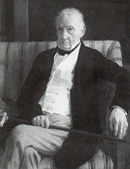

René-Hilaire Degas, born in Orleans, France, fled to Italy during the French Revolution with his wife Jeanne-Aurora Frappa from New Orleans, LA. Of seven children, the oldest, L.P. Augustin-Hyacinthe Degas an Italian-born banker of Naples, married Miss Marie Célestine Musson from Louisiana on July 7, 1832 in Paris...
thus linking the Musson family of New Orleans
Fig.2
René-HIlaire Degas
by Degas, 1857
Oil on canvas.
Musée d'Orsay. Lemoisne 27.
(Edgar Degas’ paternal grandfather)
Born: 1770
New Orleans, France
Died: 1858
J.B. Germain Musson; was born in Port-au-Prince in 1787. Germain was a French Huguenot (a member of the Protestant Reformed Church of France) who fled to New Orleans in 1810. He married Marie Céleste Désirée Rillieux from a prominent French-Creole family. Through his maternal grandmother, Marie Céleste Rillieux, Edgar Degas was related to the black inventor and engineer, Norbet Rillieux, Edgar’s mother’s first cousin. Norbet became a professor of engineering at the Ecole Centrale in Paris and invented the double evaporation process of sugar refining.
In 1812, the city of New Orleans expanded rapidly by exporting cotton and surgercane up the Mississippi River. Germain Musson, a cotton merchant, had his ships carry cotton to Boston and returned with granite as ballast for his ships. With this granite material, he erected a building in 1833 at the corner of Canal and Royal Streets, known as “Musson’s Fort.”
In 1819, at the age of twenty-five, Marie Céleste died and Germain returned to Paris with his five children: Michael, Eugene, Henri, Anne and Marie-Célestine. He later returned to the States shortly after his daughter, Marie-Célestine Musson, married Auguste De Gas in New Orleans, while daughter Anne remained in Paris with her brothers, Henri and Eugene. During his travels from the States to France, Germain was in Paris for the birth and baptism of his grandson, Edgar Degas in 1834.
Not only dealing cotton in New Orleans, Germain Musson also mined silver in Mexico, where he was killed when his coach overturned in 1853.
Fig. 2. Degas and New Orleans: A French Impressionist in American, 1999, New Orleans Museum of Art, page 107.